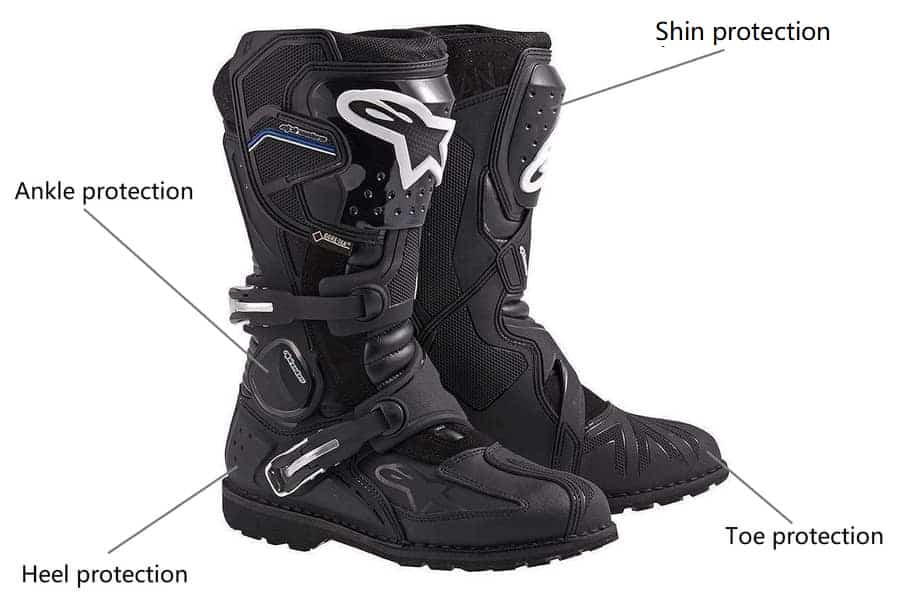When it comes to motorcycle riding, safety is paramount. However, figuring out what you need in order to be safe can be a difficult task. You know you need a helmet, but what other gear is important to save your life and limbs while riding? In this guide, we’ll run through some of the key factors you’ll need to think about when choosing which pair of motorcycle boots you’ll buy. Learn what safety features are important and which ones are a matter of preference.
While the exact safety features on a pair of motorcycle boots will vary based on opinion, comfort, and purpose, in general it is recommended to wear motorcycle boots with a low heel and steel toes. These additions to your boot may be the elements that save you from a severed foot or damaged ankle.
If you want to know more about why steel toes and heels matter, we’ll dig deeper in the following sections. We’ll also talk about other elements of boot safety, such as what material it should be made from, what the fit should be, and why, exactly, motorcycle boots matter.
Do motorcycle boot heels and steel toes make a difference?
Let’s start by talking about motorcycle boot heels. In general, motorcycle boots have a lower heel than the typical work boot, but they aren’t completely flat. What does the heel do for a motorcycle rider? The heel holds your foot in place on the foot peg and protects you from sliding.
While riding, you may need to come to a sudden stop. If your boots have a smooth, flat sole, there’s a high possibility of slipping. As you can imagine, letting your foot slip off the peg when riding at high speeds can end in disaster. To avoid this, you can purchase motorcycle boots with a low heel that will catch against the peg even in a drastic stop or turn.
One thing to note is that a heel may also make it difficult to practice correct foot placement. It’s important to learn proper riding positions and make sure that you aren’t placing your foot on the peg incorrectly due to the heel. In addition, a higher heel may make it more difficult to shift and may inhibit mobility. Because of this, it’s recommended that the heel be no higher than a half inch.
Now, on to steel toes. There is much debate in the motorcycle world on whether or not to wear steel toes. Much of this is based on the fear that the steel toe could separate from the boot and sever your toes. While this is a valid fear, the reality is that such a scenario is unlikely to happen.
Steel toed boots are made with plenty of safeguards in place meant to protect your toes. The dangers of wearing a shoe without adequate toe protection are much greater than the small change of damage occurring because of the steel toe. The unfortunate truth is that in a situation where the steel toe may be crushed or broken, your foot wouldn’t stand a chance without the steel either.

What do motorcycle boots protect from?
We’ve talked about the ways that heels and steel toes can protect you. What else do motorcycle boots need to accomplish for the rider? Motorcycle footwear needs to accomplish a lot. Not only will good boots protect you from abrasion in the event of a crash, but they’ll also protect you from crush impacts and cuts and penetration. In addition, good footwear needs to be oil-resistant, weatherproof, and durable.
One of the most important elements for motorcycles is oil resistance. When working with bikes, there’s a high chance of coming into contact with oil spills and other liquids. Motorcycle boots need to be able to withstand this wear and tear as well as maintain grip even after coming into contact with oil. If your motorcycle boots aren’t oil-resistant, you might as well be wearing a pair of sneakers.
Another important factor to consider is the weatherproofing of the boot. Depending on your intended use, your motorcycle boots may not need to withstand constant rain and wind. However, they should have some amount of weather-protection and durability. This is why it’s essential to have boots made of treated leather, since it will hold up better in harsh conditions.
Your boots may have different protective elements depending on your use for them. If you race on a track, the boots will need to be able to hit the pavement at high speeds. If you ride on dirt and off-road, you’ll need boots with improved durability. If you just need a pair of boots for your commute to work, you may want to focus a little more on comfort.
What material should motorcycle boots be made from?
The protective elements of boots leads to another question, which is the matter of material. Not all materials are equal when it comes to riding boots. One of the most common materials for motorcycle boots, whether for racing, touring, or cruising, is leather. Thick, treated leather has high impact resistance and can outlast many other materials.
In addition to a thick leather, boots should have double enforcement on high-wear areas such as the toe and ankle. These might be also made from leather or from tough plastic or carbon fiber. If you choose not to use steel toe shoes, you’ll want to make sure that the boot has some reinforcement on the toe area. There are some good options made of carbon fiber that are comparable to steel toes.
Boots aren’t just about having a hardy exterior though. Your motorcycle boots should have a breathable lining for temperature regulation and comfort. Some steel toed boots can be cold in the winter, so you’ll want to consider the conditions under which you’ll be using the boots and make sure the inner material is comfortable.
As far as the sole, you want a rubber sole with just enough texture to give you good grip, but not so much that it limits your mobility. As mentioned previously, they need to be oil-resistant and weatherproof. Leather soles are too slick and not as durable; therefore, they are not recommended.
How do you ensure a good fit for your motorcycle boots?
Your motorcycle shoes need to fit well, since they’ll be your constant companion when riding. If you aren’t sure how to find boots that fit well, we can help you look for signs of ill-fitting boots.
Before you even try on a pair of boots, you’ll want to consider your socks. If you live somewhere cold and will be wearing thick socks while riding, you should have those socks on to try the boots. You also need to decide if you need boots that will go under or over your pants while you ride, since this will affect the fit.
Your new motorcycle boots should be stiff but not tight. It’s important that your toes have plenty of wiggle room, but your foot shouldn’t be sliding around inside the shoe. The boot should be tight around your ankle. One important thing to note is that your boots need to extend above your ankle in order to properly protect you. Under the ankle boots will not guarantee the safety of your foot.
After purchasing your boots, you’ll want to wear them in for a few days before riding with them. Start by putting them on to walk around and get used to the fit. In most cases, it will take about a week before the boots have adjusted to your foot size and are comfortable and adjusted. Give it time!
Protect yourself while riding
Riding a motorcycle requires some amount of preparation and protection. There are many dangers that come along with riding, so it’s important to focus on protecting yourself as much as possible. In order to do that, one element to consider is footwear.
Don’t skimp out on your motorcycle boots. The pair of work boots you have sitting in the closet won’t cut it for motorcycle riding. Instead, purchase a pair of designated motorcycle boots, with a thick leather exterior, carbon fiber reinforcements, a low heel, and a steel toe for ultimate food and ankle protection while riding.
It may not seem like boots are the top priority in terms of motorcycle gear, but you’ll be glad you took the time to invest in this foot protection when you hear stories of lost limbs or find your own toes and feet protected in an accident. In short, when it comes to the question “should my motorcycle boots have heels and steel toes?” the answer is “depends on whether or not you’d like to keep your feet!” In this case, we suggest that the protection is worth it.
